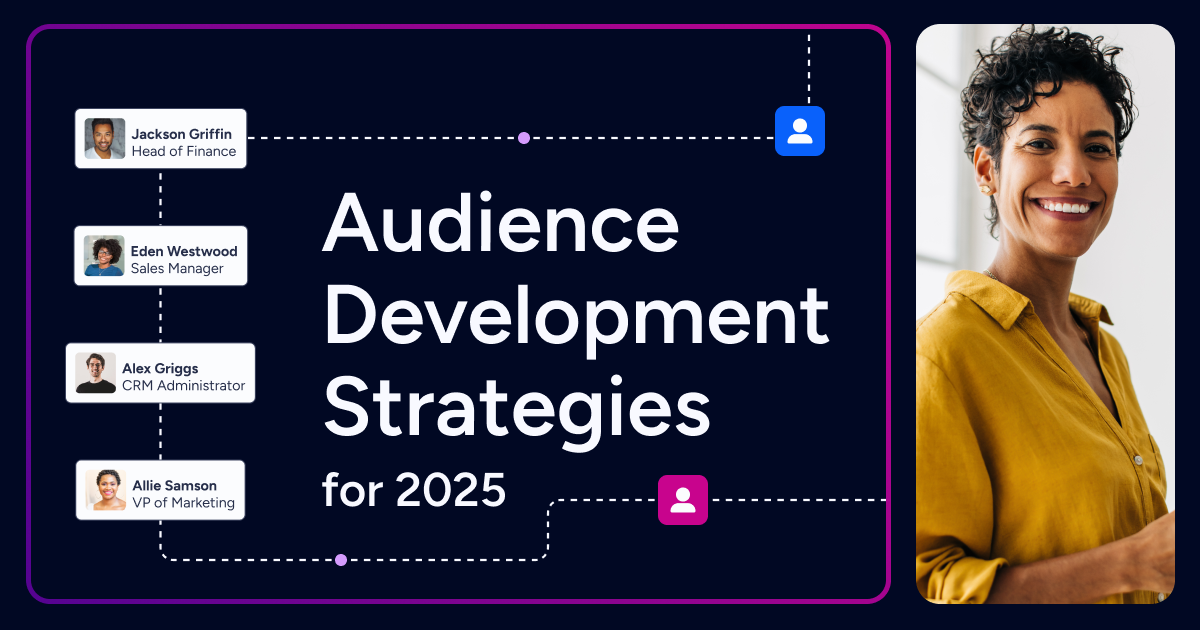Not too long ago, a strong audience development strategy meant casting a wide net into a rising economic tide. But today, precision is key. For B2B go-to-market teams, audience development is really about using the right tools and messages to reach your ideal prospects when they’re ready to buy.
The difference is smarter data. AI and machine learning help leading teams cut through the noise and drive real results, turning a strong audience development strategy into action. It’s how modern GTM teams master the modern buyer’s journey to grow faster and convert more.
What is Audience Development?
Audience development is the practice of building and nurturing a target audience through data-driven marketing. The goal is to create stronger relationships with existing, former and potential customers, while also expanding the customer base and increasing loyalty.
How This Strategy Has Changed Over Time
In the past, audience development emphasized volume-driven growth and maximizing audience size, sometimes regardless of fit. Today, the focus has shifted to quality-driven growth, which produces more consistent, long-term revenue and deeper customer loyalty.
The Role of Data in Audience Development
While first-party data plays an important role, marketers now also lean heavily on third-party data and intent-based signals. These richer data sources make it possible to:
Predict customer needs and desires
Deliver more personalized experiences
Strengthen long-term brand relationships
Creating Integrated Cross-Channel Journeys Through AI
Modern audience development goes beyond isolated tactics. Today, it’s about creating unified, consistent experiences, no matter where or how someone interacts with your brand.
Marketers use AI and real-time data to:
Coordinate messaging across email, social, web and mobile
Respond to customer behaviors as they happen
Meet users with relevant content at each stage of the journey
From awareness to advocacy, the journey is no longer linear, but connected. That connection is what powers deeper audience relationships.
Why Audience Development Needs a Reboot
Professionals are increasingly using generative AI tools to answer questions, learn and research products and services, and select a short list of providers. With clicks decreasing, traditional SEO and content marketing may not yield the same results they used to.
As AI-driven discoveries rise, audience development strategy needs to make sure it’s not stuck in the past.
7 Winning Audience Development Strategies
If you’re looking to revamp your tactics, here are some proven audience development strategies built for 2025 and beyond.
1. Leverage Third-Party & Intent Data for Precision Targeting
What this strategy involves: First-party data is the data a business collects from its own audience, through its own channels. Third-party data covers contacts and companies that aren’t already in a business’ database. Intent data indicates when a prospect might be ready to buy, or when a customer might churn or want to expand.
Leveraging these types of data for precision targeting allows for granular approaches to delivering ads, customer rewards and more to different audience segments.
Why this strategy is effective: It’s based on real demographic and behavioral data that your business actually owns and can leverage.
How ZoomInfo can help: With ZoomInfo intent data, you can spot which companies are actively researching topics relevant to your business. Paired with our data enrichment and contact & company search, your team can sharpen targeting by filling in missing firmographic and technographic details, ensuring you reach the right people at the right time.
2. Personalize Journeys with AI and Predictive Insights
What this strategy involves: As audience needs change over time, using AI and predictive insights to personalize customer journeys can help with both audience growth and customer loyalty.
Why this strategy is effective: As more people use AI, the expectation for personalization is only going to grow. Brands that adopt both AI and predictive insights to meet customer needs before they’re expressed will see greater loyalty and revenue generation.
How ZoomInfo can help: ZoomInfo Copilot uses AI to recommend the best accounts and contacts, while workflow tools help you trigger timely, personalized outreach. Tools like FormComplete let you turn inbound visitors into qualified opportunities instantly, tying personalization directly into your customer journey.
3. Build Communities, Not Just Lists
What this strategy involves: Actual audience engagement that goes beyond just triggering emails from your CRM. While lists can form the basis of a community, with good data and excellent audience segmentation, community building around a brand, product or service is more than possible.
Why this strategy is effective: You don’t have to have detailed psychographic data to understand that people like to be a part of something that feels authentic. By aiming to build communities, brands can encourage natural engagement.
How ZoomInfo can help: With contact & company search and ideal customer profile (ICP) modeling, you can find prospects who are more likely to participate in and benefit from your community initiatives. Ad targeting then helps you nurture those communities by delivering consistent, relevant messaging across digital touchpoints.
4. Orchestrate Multi-Channel Audience Engagement
What this strategy involves: From generating brand awareness via display ads to moving a warm lead down the funnel, orchestrating multi-channel audience engagement is a must for audience development.
Why this strategy is effective: Your audience wants to feel like they’re more than just demographic data. With multi-channel offerings that offer real value, engagement, familiarity and trust will follow.
How ZoomInfo can help: ZoomInfo Marketing makes it possible to activate enriched audiences across email, social and digital ads. And with integrations through our cloud partners, your marketing and sales teams can stay aligned, ensuring consistent multi-channel orchestration.
5. Invest in Interactive & Immersive Content
What this strategy involves: B2B content strategy is shifting toward more interactive, immersive experiences. By using formats like VR, AR or choose-your-own-adventure storytelling, brands can turn passive audiences into active participants and loyal customers.
Why this strategy is effective: People are looking for a unique and memorable user experience. Valuable content that invites participation is not only unique, but it can also breed loyalty.
How ZoomInfo can help: FormComplete reveals who’s engaging with your digital experiences — even if they don’t fill out a form. Combine that with Chorus for conversation intelligence, and you can design follow-up campaigns that feel truly interactive, responding to what your audience is showing interest in right now.
6. Optimize for Search & Discovery Everywhere
What this strategy involves: How consumers and companies get their information and do their research is more fractured than ever. From influencers and genAI search engines to podcasts, it’s essential for brands to optimize for search and discovery everywhere their audience is.
Why this strategy is effective: Optimizing for discovery across channels increases your chances of reaching the right audience in the right place. Despite its broad appearance, this approach is still highly targeted, as it’s driven by data like demographics and user behavior. That data helps focus your efforts, so you're not wasting resources trying to cover the entire internet.
How ZoomInfo can help: With intent data, you can uncover the exact keywords, topics and signals that drive discovery in your target accounts. Then, by layering on ad targeting and data enrichment, you can meet prospects where they are without losing visibility into who’s engaging.
7. Measure What Matters: Audience Quality Over Volume
What this strategy involves: With the right kinds of metrics and information, you can build a high-quality audience with high customer lifetime value. When these types of audiences are nurtured properly, it leads to referrals and further audience expansion. Knowing what to measure and how to engage them is key here.
Why this strategy is effective: Which is better: 100 customers who buy a $5 item once or 20 customers who buy that same $5 item once a month for a decade? When you’re developing your audience, put more of your efforts into engaging and retaining quality customers.
How ZoomInfo can help: ZoomInfo Operations keeps your audience data clean and accurate, while Data as a Service integrates that data directly into your CRM or analytics stack. This allows you to measure engagement and pipeline quality with confidence, moving beyond vanity metrics to demonstrate real audience value.
How ZoomInfo Can Accelerate Your 2025 Audience Strategy
Audience development in 2025 demands smarter data, faster insights and more personalized execution. ZoomInfo equips teams with the visibility and tools they need to meet today’s demands and tomorrow’s opportunities.
Here’s how we help put your strategy into action:
Tap into real-time intent signals and zero-party data to segment audiences with precision
Use predictive engagement data to prioritize high-value prospects and personalize outreach
Convert anonymous web traffic into known contacts, fueling both top-of-funnel and nurture campaigns
Enrich your CRM with firmographic and technographic insights to unlock new down-funnel opportunities
By connecting data, targeting and timing, we can help you scale audience development in a way that’s both intelligent and measurable.
Next Steps — Build Your Audience Strategy for 2025 & Beyond
It’s time to craft an audience development strategy that’s designed to win. With ZoomInfo, you not only get the business intelligence and data you need to guide your marketing, sales and customer success motions, but you also get easy-to-use products and infrastructure designed to help your company compete.


